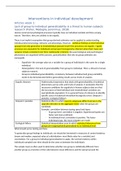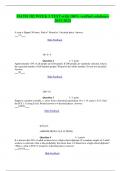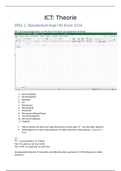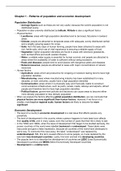Articles week 1:
Lack of group-to-individual generalizability is a threat to human subjects
research (Fisher, Medaglia, Jeronimus, 2018)
Human social and psychological processes typically have an individual variable and time-varying
nature. Therefore, they are unlikely to be ergodic.
There is an implicit assumption that group-derived estimates can be applied to understanding
individual phenomenology, behavior and physiology. However, statistical findings at interindividual
(group) level only generalize to intraindividual (person) level if the processes are ergodic. Ergodic
processes are equivalent for individuals and groups (homogeneity criterion) when their mean and
variance remain consistent over time (stationarity criterion). Because biological and psychological
phenomena are organized within persons, generalizations that rely on group estimates are
nonergodic.
- Ergodicity= the average value on a variable for a group of individuals is the same for a single
individual.
- Nonergodicity= the lack of generalizability from group to individual. This is a threat to human
subjects research.
- Group-to-individual generalizability; consistency between individual and group variability
needs to be demonstrated before generalizing results across levels of analysis.
Ergodic theorem Mathematical expression that deals with generalizability of statistical
phenomena across units and levels of analysis. It postulates that the
necessary conditions for ergodicity in human subjects data are that
the structures of interindividual and intraindividual variations are
asymptotically equivalent. It is a general frame of reference to identify
specific cases of statistical inferential/incongruity errors (Simpson’s
paradox, ecological fallacy).
Simpson’s paradox Statistical effect in which trend in subgroups differ from/are in the
opposite direction to the aggregate trend when the groups are
combined.
Example: correlation between typing speed and typos.
- At group level; correlation is negative. Experienced typists are
faster and more proficient.
- At individual level; correlation is positive. The faster
individuals type, the more mistakes are made.
Ecological fallacy Statistical interpretation error in which statistical inferences from
groups are inappropriately generalized to an individual level.
What should we be testing and how:
To generalize group findings to individuals, we should be interested in measures of central tendency
(mean and median, expected value of a distribution= most likely value for a variable) and
covariations. For a group-to-individual generalization to apply, the central tendency within
individuals sampled over time should be the same as between the individuals.
The sample mean is often used to determine whether one group is statistically different from
another group as a function of the ratio between mean difference and the spread around the
,difference (SE). This is a signal-to-noise ratio; signals that are roughly twice as big as the size of the
respective noise are considered statistically significant.
Results: there are disagreements between individual and group estimates and consequently for
generalizing group data to individuals. Correlations between variables within individuals exhibited at
least twice as much variation as those found within groups. Taxonomic decisions based on group
correlation between these dimensions would likely lack ecological and clinical validity and can
undermine treatment planning and outcomes.
Tests that assume normality may be more appropriate for between-subjects analyses than for within-
subjects analyses and the SE of the mean may be a more appropriate measure for interindividual
variability.
Personalized models of psychopathology (Wright & Woods, 2020)
Personalized approach to psychopathology defines a mental disorder as a complex system of
contextualized dynamic processes that is nontrivially specific to each individual and seeks to develop
formal idiographic statistical models to represent these individual processes.
- Psychopathology is highly heterogeneous in its manifestations
- Models based on between-person structures do not directly identify mechanistic processes at
the level that is necessary for intervention
- Within-person process-based models should be developed for each patient in order to
provide a tailor-made understanding for the unique presentation of the mental disorder
Polythetic criteria Psychiatric diagnoses generally require that some subset of the total
criteria (not all) be present in order to assign a diagnosis. Features
such as polythetic criteria sets and subtype specified attempt to
accommodate the observed clinical heterogeneity.
Nomothetic The scientific pursuit of generalizable laws/principles. In psychology,
it refers to the search for principles that are true of all individuals in
a group/population. Nomothetic models tell us how individuals
differ from each other but not how any one person differs from
themselves at different points in time.
Idiographic The scientific study of a specific instance (for example, one country/
language). In psychology, it refers to the study of each individual.
Psychopathology has been conceptualized as an idiographic
phenomenon. Clinical theories are generally derived from
nomothetic principles, but clinicians often tailer these general
principles to the specific presentation of the patient.
Ergodicity Property whereby each individual component (person) of a dynamic
system is equally representative of the whole group (population).
The key point is that there is no mathematical requirement for
within-individual processes of an individual to follow the same form
as between-person structure.
Theoretical principles are useful because they provide an organizational scaffolding to understand
processes of psychopathology in patients. They also provide a common language for communication
with other clinicians or researchers. However, no one theoretical model can adequately explain each
individual’s pathology.
,Functional analysis in applied behavior analysis is an example of a tool of idiographic assessment. The
therapist tries to establish antecedent conditions that elicit a target behavior within a patient.
Why should we personalize psychopathology now; it reflects the confluence of 3 streams of relevant
technological and conceptual developments that corresponds to 3 major components of scientific
inquiry (theory, data capture, statistical analysis);
1. In the 1970s, the Kraepelinian movement was a major transformative force in clinical
psychology and psychiatry. This lead to validating mental disorders as discrete disorders.
Nowadays, we realize that this approach has limitations.
2. The rise of intensive longitudinal data sampling provided the necessary multivariate dynamic
data sampled enough times to develop a model for each individual.
3. There has been an increase in statistical models that are developed for the analysis of
multivariate intensively sampled data and the computation architecture needed to support
their easy implementation.
Almost all ideographic research relies on longitudinal data (collected over time and across
situations). But for how long should data be collected and at what frequency?
- Burst assessment; longer-term assessment with lesser participant burden. The individual is
intensively sample for several days at a time with weeks/months between assessment
intervals.
- Individuals may be intensively sampled for days to weeks, but this may need to be scaled
back to once a day over months or longer.
Idiographic batteries/items offer the highest degree of personalization and therefore increase
validity, sensitivity and predictive power for a given individual. They also make any integration/
comparison with results of others or the generalization of the principles more challenging.
Multilevel model= most common model used for studying within-person processes. May seem
idiographic in the sense that they model within-person variations and accommodate individual
differences in values with random effects. However, the actual model does not estimate person-
specific effects but is rather based on the estimation of an average fixed effect.
Vector autoregression (VAR)= one of the most common idiographic analytic techniques. Has two
components;
1. Autoregressive effects; estimates the extent to which a variable predicts itself at a later point
in time. The tendency for a state to persist over time.
Positive values reflect a tendency to persist in a state.
Negative values suggest a regulatory/compensatory process operant between
observations.
2. Cross-lagged effects; estimates the effect of variable A at time 1 on variable B at time 2.
p-technique; reveals the dynamic structure of an individual’s multivariate time series, but the
associations among factors remain contemporaneous, not lagged. Dynamic factor analysis (DFA);
extends the basic p-technique model to include structural paths across waves.
Network approach; relies on use of graph theory metrics but has stumbled on the path to generating
novel insights precisely because of its reliance on between-person data when conceptually it seeks to
describe dynamic processes.
Can models generalize from individuals to populations;
, The use of idiographic research includes lack of generalizability and difficulty of scaling up to large
numbers of participants. Personalized psychopathology models are not generalizable, they are
tailored to fit only one individual’s process. These models also offer direct and more precise
measurements of contextualized dynamic processes that could serve as building blocks for bottom-
up models of psychopathology that would be generalizable.
Explanatory approach Research primarily searches to explain causal mechanisms that drive
behavior.
Predictive approach Focuses on accurately detecting/predicting behavior. Understanding
the underlying mechanisms is secondary. The ability to collect large
quantities of data via intensive repeated measurements gives
possibilities for this approach in personalized psychopathology
practice/ research. Being able to predict/prevent behavior is valuable
when the goal is to intervene in behavior.
Surface personalization Idiosyncratic manifestations of the same pathology.
- Example; behavior analysis. It is explicitly assumed that
processes are shared across individuals and they differ merely
in their idiosyncratic manifestations (one may be afraid of dogs,
the other of spiders).
Deep personalization Individualized processes.
- Though all organisms may share the negative reinforcement
process, one individual’s maladaptive negative reinforcement
process may stem from substance withdrawal while another
may manifest as avoidance.
A network theory of mental disorders (Denny Borsboom, 2017)
Network approach to psychopathology is an alternative way of conceptualizing mental disorders.
Mental disorders arise from direct interactions between different symptoms. Symptoms are causally
connected through myriads of psychological, societal and biological mechanisms. If the causal
relations are strong enough, symptoms can generate a level of feedback that renders them self-
sustaining.
- The term disease implies a worked out etiology. Symptoms arise from a common pathogenic
pathway.
- The term mental disorder implies to a syndromic constellation of symptoms that empirically
hang together for unknown reasons.
Psychiatric symptoms have been argued to cause each other instead of being effects of a common
cause. Symptoms form feedback loops that leads the individual to spiral down into a prolonged state
of symptom activation, which we call a mental disorder.
Network approach to The interactions between symptoms can be described as a
psychopathology network, in which symptoms are nodes and causal interactions
between symptoms are connections between the nodes.
Symptom networks:
Presence of causal connections means that, in the case that an intervention changed the state of one
symptom, this would change the probability distribution of other symptoms too. Direct causal
connections may be grounded in biological or psychological processes, homeostatic couplings,
societal norms or in other processes.











